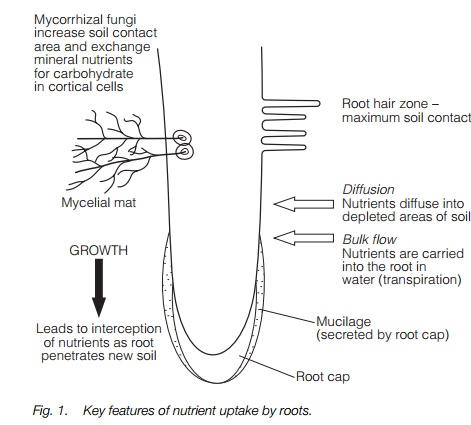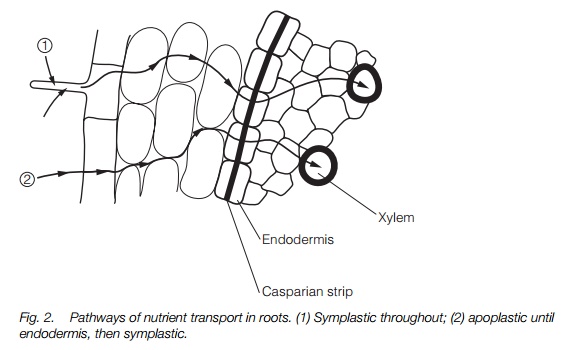Chapter: Plant Biology : Plants, water and mineral nutrition
Uptake of mineral nutrients by plants
UPTAKE OF MINERAL NUTRIENTS BY PLANTS
Key Notes
Key properties of nutrients
The majority of plant nutrients are taken up by the plant in ionized form from films of water surrounding soil particles. Nutrients move in aqueous solution. They cannot cross lipid membranes unless transport proteins are present.
The soil–root interface
The root surface (the rhizodermis) makes limited contact with the nutrient film surrounding soil particles. Root hairs and, in many species, mycorrhizal fungi greatly increase the surface area in contact.
Symplastic, apoplastic or cellular?
Transport within the root may be across cell membranes (transmembrane) then through the cell cytoplasm (cellular transport) or between cells (apoplastic). Plasmodesmata provide continuous contact between the cytoplasm of adjacent cells giving direct cell-to-cell (symplastic) transport without contact with the apoplast.
The endodermis
Cells of the endodermis have suberinized cell walls which form a waterimpermeable barrier surrounding the vascular tissue of the root. It prevents apoplastic movement of nutrients which must therefore either travel symplastically through the endodermis or enter the vascular system from below the endodermis.
Transport into the xylem
Water and nutrients leaving the endodermis enter xylem parenchyma cells that surround xylem vessels. These cells actively accumulate nutrients to a high concentration before they are loaded into the xylem for transport to the rest of the plant.
Distribution in the plant
Xylem extends throughout the plant and water flows to wherever transpiration is taking place. The apoplast of all tissues is in close contact with xylem fluid and nutrients are taken up from this space by cells.Rapidly growing tissues (e.g. fruits, tubers) may have low transpiration and in these tissues redistribution of ions in the phloem may be
important.
Key properties of nutrients
Nutrients are taken up as ions dissolved in water. Bulk movement occurs in the transpiration stream (via the xylem) to shoots and leaves. Movement depends on the unique size, charge and solubility of each nutrient ion. As ions cannot cross membranes without a specific transport protein being present, their uptake into cells and into the root can be regulated. This means that roots accumulate some ions against a concentration gradient, while others are excluded and some ions move through cells while others move in intercellular spaces.
The soil–root interface
Roots elongate into the soil by growth near the tip, pushing the root cap between soil particles . They deplete their immediate soil environment of nutrients creating a depletion zone. Good root-to-soil contact is provided by the secretions of the root cap and by root hairs. Fibrous root systems, made up of fine roots with many root hairs, maximize the area available for uptake. In addition, many species have mycorrhizal fungi in symbiotic association with the root which greatly enlarge the available soil area from which nutrients are extracted . Nutrients become available at the root surface as a result of three processes: interception, growth of roots into new nutrient-rich area; massflow, movement of ions in the water flow driven by transpiration; and diffusion, passive movement of ions to regions depleted in nutrients (Fig. 1).

Symplastic, apoplastic or cellular?
Nutrient ions entering the root at the root hairs may travel directly through the cell cytoplasm until they reach the vascular tissue (Fig. 2). Cells of the rhizodermis (root epidermis) are linked by plasmodesmata to adjacent cells and solutes can move from cell to cell directly. Transport through the cell via plasmodesmata is termed symplastic transport. The second form of transport, apoplastic transport is through the walls of root cells. Water and nutrients can travel through this region (the apoplast) until the endodermis, where water and nutrients must cross a plasma membrane and enter a cell symplasm (cellulartransport). Water and nutrients may also enter cells via the plasma membrane (transmembrane transport), then leave the cell to enter the apoplast before being taken up across the plasma membrane of an adjacent cell.

The endodermis
The endodermis develops near the point of development of the root vascular tissue . Cells of the endodermis have suberinized cell walls which form a water-impermeable barrier surrounding the vascular tissue of the root. This prevents water and nutrients moving into the vascular tissue through the apoplast and the only transport possible at this point is symplastic. Most nutrient ions entering the vascular tissue will therefore have passed through living root cells at some point. This permits selectivity and filtration of the transported ions. Older endodermal cells become entirely enclosed in a suberin, layer. These cells provide a barrier to the back-flow of water from the xylem.
Transport into the xylem
After crossing the endodermis, ions enter the xylem from the cells surrounding it, the xylem parenchyma. These cells actively accumulate nutrients to a high concentration before they are loaded into the xylem for transport to the rest of the plant. Influx into the xylem occurs via specific membrane proteins down the concentration gradient. Nutrient flow in the xylem to leaves and shoots occurs in the transpiration stream.
Distribution in the plant
Mineral nutrient ions and water move in the xylem and reach all parts of the plant. Xylem tubules branch out from the main vascular bundles of the stem to reach leaves and buds and branch again to form finer tubules in the leaf veins. Water and nutrients leave these tubules as water evaporates from the leaf surface; the cells of the leaf are surrounded by water and dissolved nutrients which permeate the leaf wall spaces (leaf apoplast). Cells extract water and nutrients from this. Some nutrient ions may be redistributed through the plant in the phloem, while others only move in the xylem. Some areas of the plant undergoing rapid growth, e.g. fruits and tubers, do not have high transpiration rates and the xylem flow is low. This may lead to nutrient deficiency if nutrient transport in the phloem does not occur. Blossom end rot of tomato occurs in these circumstances, due to lack of calcium. Ions may be moved from xylem to phloem by transfer cells that lie between the two pathways or ions may leave source tissue as it loads organic nutrients into the phloem. Not all ions are phloem mobile and there are marked differences between species.
Related Topics